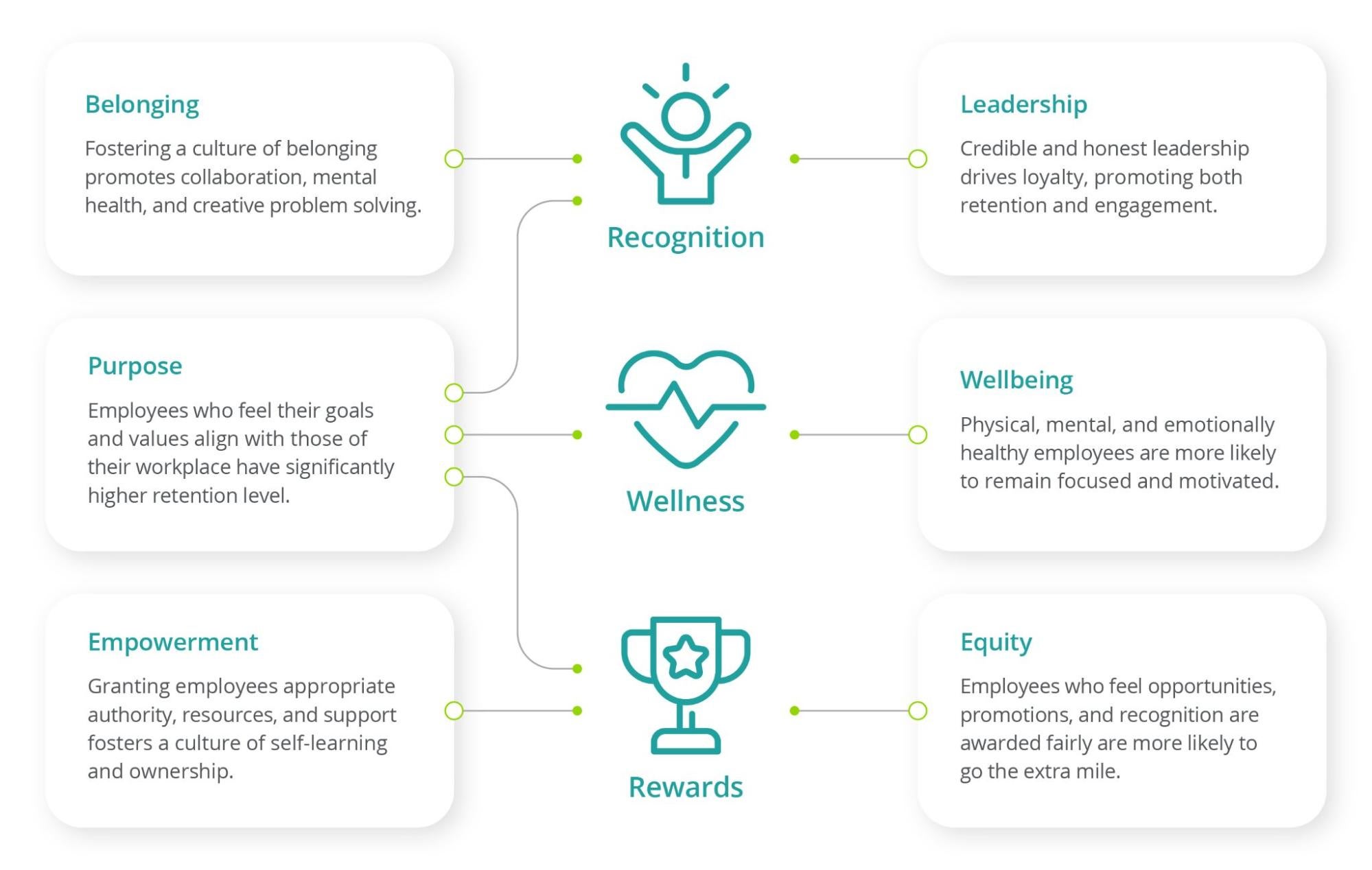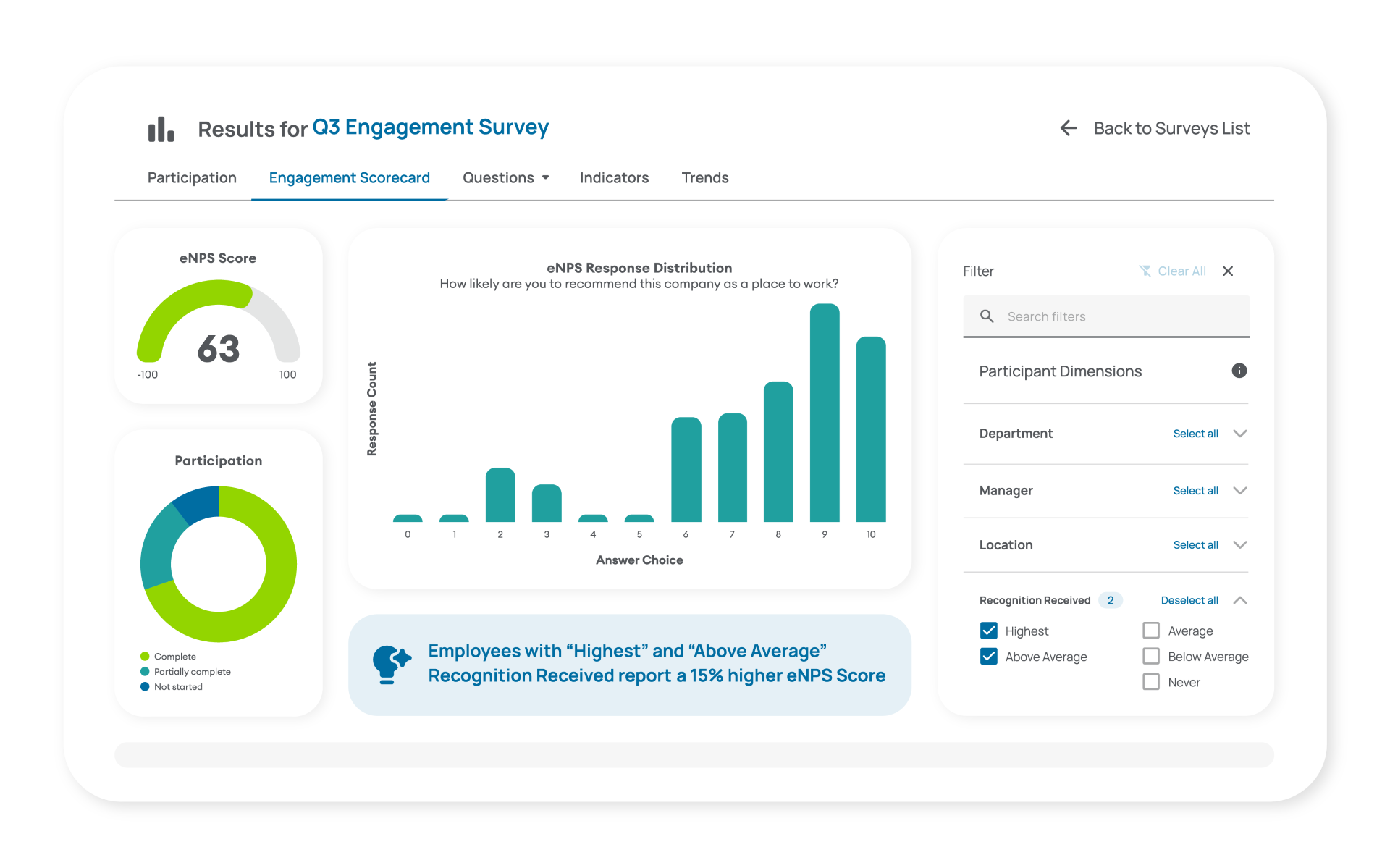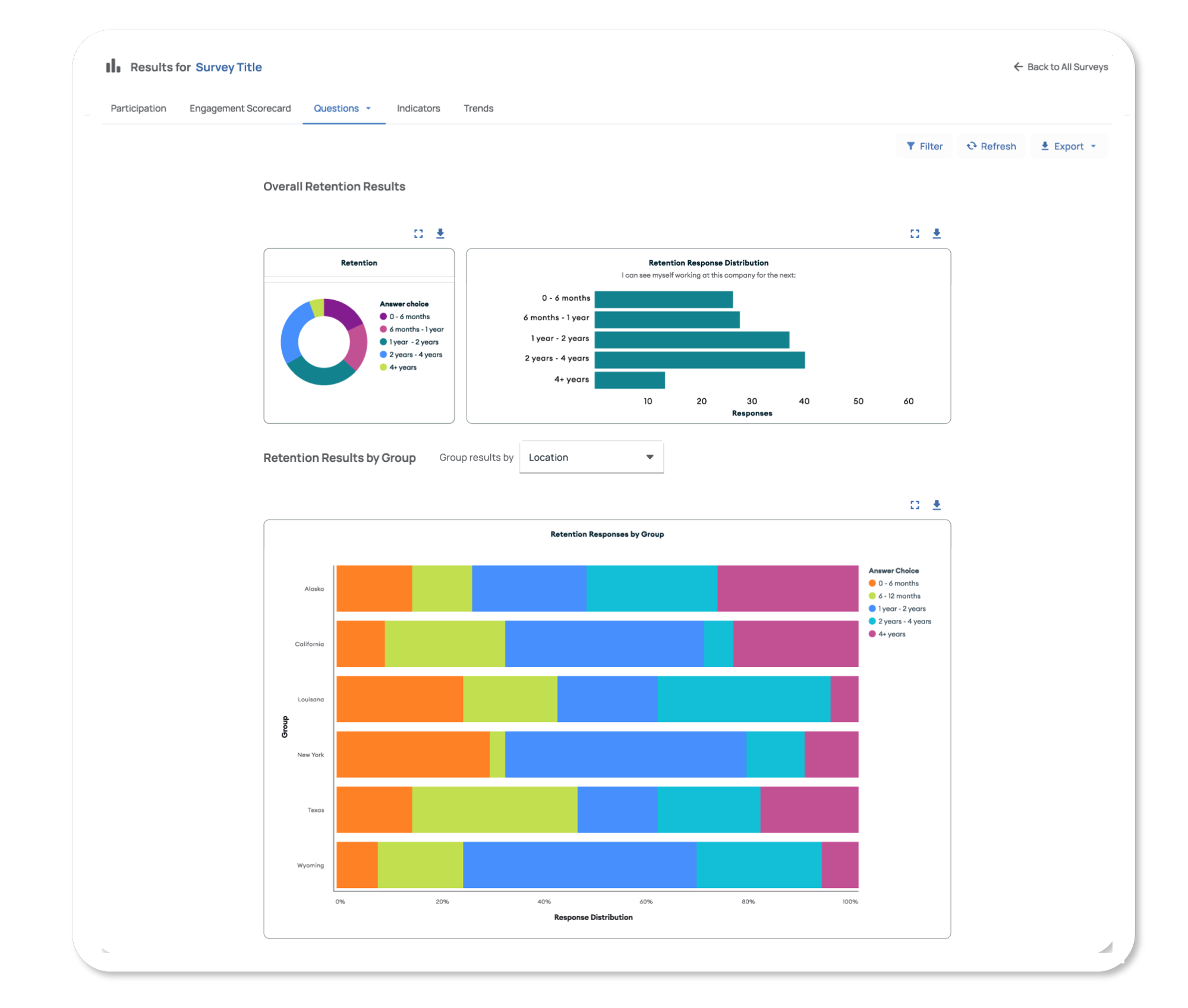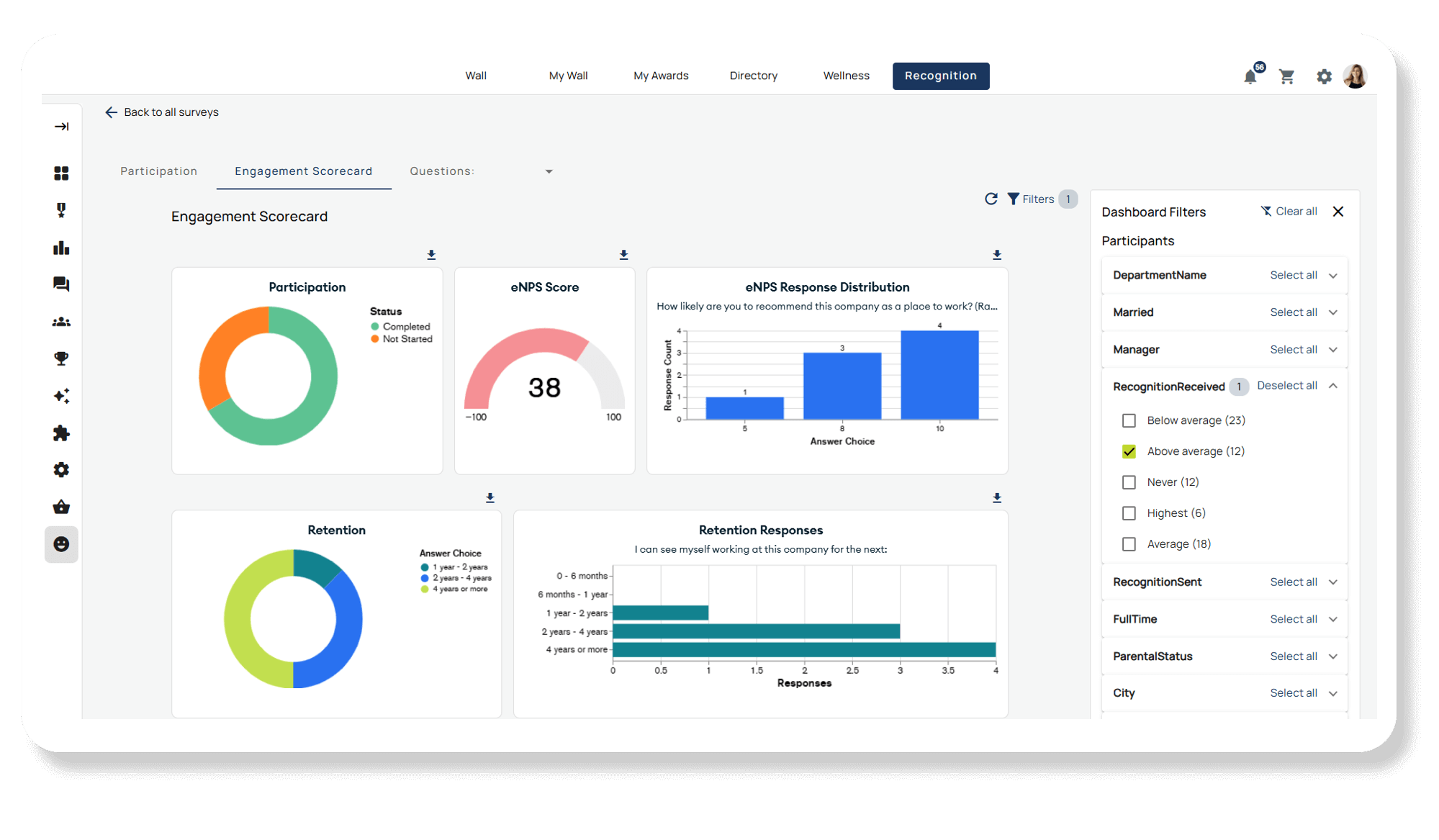April 9, 2025

Most guides to employee engagement offer an oversimplified approach to improving it: it’s usually about better communication, adding fun team activities, or rewarding employees for their work. But what if a team is already at the edge of burnout? Or what if some people feel there’s little prospect of growth at the company? In this case, fun events or games aren’t going to cut it.
Employee engagement is often presented as having an easy fix: just add a social recognition platform, and your team will be delighted to log in, send words of encouragement and appreciation to each other, and get fun gifts as a thank you. But what if some employees aren’t being recognized enough, or the platform isn’t getting used to its full potential?
Another problem with the quick-fix approach is that it doesn’t consider the character of different teams. For example, competitions and prizes may motivate sales teams—but tournaments won’t work for every department. Same goes for activities: try getting your IT department to take part in an improv class as a morale-boosting exercise and see what they have to say about it.
The quick-fix approach assumes employees share the same interests, goals, and preferences. But do team leads and entry-level employees care about the same things? What about parents, recent college grads, or employees in different departments like accounting?
Lastly, quick-fix models stop working as soon as employees’ motivations or work environment change. New life events, like caring for an ailing family member, can make happy hours less appealing. New management hires? New team dynamics can completely shift how a team feels about their work, for better or worse.
The same goes for company-wide changes, like a tougher economic climate or a smaller employee engagement budget. Relying solely on one type of employee engagement program, like handing out company swag, makes it harder to adapt—especially during “more with less” times, when engagement is more likely to drop.
In our experience, companies can’t improve employee engagement without understanding why team members aren’t engaged in the first place.
That’s why Terryberry uses a model based on 6 employee engagement factors to diagnose and address the root causes of low engagement scores.
But before we dive into the factors that influence employee engagement, let’s make sure we have a shared understanding of what “employee engagement” actually means.
What Employee Engagement Is (And Is Not)
Depending on which article you’re reading, you may see employee engagement defined as participation in company activities or HR initiatives. But employee engagement goes beyond joining a team meeting or liking a Slack update. It’s not just about nominating someone for a reward or how many compliments are posted on a social recognition platform—though those things are nice.
While rewards, awards, and recognition are essential tools in the HR toolbox, these things don’t fully define people’s working experience.
Employee satisfaction is another factor often associated with engagement, measuring how content employees are with their job and work environment. However, measuring satisfaction alone won’t give you the full picture.
So, what is employee engagement exactly?
We define it as the degree to which employees feel aligned with company goals and motivated to perform well in their jobs. This suggests that employee engagement involves more than enjoying social interactions at work, finding job tasks manageable, or feeling appreciated.
In fact, our model identifies 6 key factors of employee engagement that all influence how engaged your employees feel at work.
6 Factors That Influence Employee Engagement

In our employee engagement model, we identify 6 key factors that determine the level of employee engagement:
- Belonging: Feeling safe, accepted, and connected to others.
- Leadership: Feeling supported, having the tools needed to perform well, and trusting managers to make good decisions and share relevant company information.
- Equity: Feeling that resources and opportunities are allocated according to individual needs, such as workplace accommodations (e.g., ergonomic keyboards or flexible work schedules) and equitable access to opportunities through coaching and hiring practices.
- Purpose: Deriving a sense of purpose from one’s work, whether through alignment with the company mission (especially in non-profits) or opportunities to share personal passions. For example, employees leading volunteering or wellness programs aligned with their interests often experience a higher sense of purpose.
- Empowerment: Feeling valued and respected, with enough autonomy to make decisions and take ownership of their work.
- Well-being: Focusing on employees’ physical, mental, and emotional health, and helping them maintain a healthy work-life balance.
How to Implement the Employee Engagement Model
Watch our webinar to learn how to leverage this model at your company to improve engagement, increase productivity, and retain your best-performing employees.
7 Best Practices for Building Employee Engagement Initiatives That Drive Long-Term Success
Many articles suggest that any employee engagement program will automatically be a success. But months later, HR teams find that their new program isn’t improving engagement because it’s not addressing the root cause of low engagement. (Not all employee engagement problems can be solved with gift cards or swag.)
From helping over 40,000 companies worldwide, we’ve learned that the most effective employee engagement programs focus on:
- Diagnosing engagement issues.
- Building tailored programs for different teams of cohorts.
- Tracking program performance.
- Connecting participation data to employee. performance and business metrics.
This is why the 7 best practices listed below—proven by companies like Ford, Unilever, Jaguar, and AstraZeneca—go against the grain of many quick-fix tips you’ll see online.
Read on to build an employee engagement program that will drive sustainable results for your organization and help you prove the ROI of boosting employee engagement.
-
- Combine different surveys & interviews for benchmarking and check-ins
- Configure surveys to uncover things you don’t already know
- Segment & analyze survey responses to find company culture across teams and cohorts
- Launch programs tailored to address existing culture flaws across teams
- Think beyond swag for employee reward programs
- Combine different types of reward programs for higher impact
- Don’t forget remote & hybrid employees
1. Combine Different Surveys & Interviews for Benchmarking and Check-Ins
Many companies rely on annual surveys to benchmark employees’ engagement, but that’s a long time to let issues that lead to low employee engagement go unaddressed. Are you willing to bet that your high-performing employees will stick around if you only fix problems affecting them 12 or 18 months later?
Instead of sending out long, detailed employee surveys once a year, combine them with more frequent pulse surveys and NPS surveys to track changes in employee satisfaction and their engagement. You can configure pulse surveys to get new information about specific engagement factors (we’ll outline this later).
You also can interview employees to understand their motivations for staying—and leaving—your company.
Exit interviews can help understand what makes employees want to leave. If you uncover specific issues that increase turnover, you’ll be able to tailor your employee engagement programs to address them.
(Or you may realize that there are deeper issues at hand.)
For example, many companies invest in reward programs while their salaries stay below average. Not surprisingly, they discover that employee engagement stays low until their salaries go up, no matter how many goodies they get in the meantime.
Stay interviews can help understand what makes employees want to stay. This is especially useful to document the aspects of your company culture that are especially valued by your top employees.
For example, you may find out that your most engaged and productive employees are motivated by challenging projects and a sense of ownership. Or you may discover that they get tokens of appreciation from their manager and that’s what drives their performance.
Ideally, you run all types of interviews and surveys consistently, so that you can track changes in engagement trends on department or team level and quickly react to them.
Once you have that baseline information, you can start digging deeper to build solid foundations for your employee engagement program initiatives.
Not sure which questions to include in surveys and interviews?
Use these sample questions as a starting point:
- 83 questions to evaluate company culture
- 32 questions for insightful pulse surveys
- 50 questions to guide your stay interviews
Terryberry offers survey functionality (including an out-of-the-box survey library) with all recognition programs.
Find out more about using Terryberry to run and analyze employee engagement surveys.
2. Configure Surveys to Uncover Things You Don’t Already Know
Using standardized survey scripts isn’t wrong, but it can waste time collecting information you already have.
For example, if your company recently implemented a “Back to the office” policy, sending out a generic job satisfaction survey asking, “Are there any aspects of your job that you find challenging or dissatisfying?” won’t provide much insight. Instead of relying on generic surveys, tailor them based on what you already know to gather useful, actionable data.
A more specific question could be: “How can we support you as we transition back to in-office work?”
If you already have employee rewards or recognition programs, use that data to shape your survey questions. For instance, if you introduced a social recognition platform to improve frontline employee experience but engagement is low, you might find that not all employees have smartphones, or some need extra help logging in.
3. Segment & Analyze Survey Responses to Find Company Culture Across Teams and Cohorts
Many guides suggest one-size-fits-all solutions for employee engagement, assuming a single program will work for everyone. But engagement varies across teams and cohorts due to different workplace experiences.
Instead of applying blanket solutions, analyze engagement, job satisfaction, or eNPS scores at the team level or within specific employee groups. This helps identify recurring issues like micromanagement or pressure to attend after-work events.
Segmenting responses by cohort—such as minority employees, new hires, long-tenured employees, or top performers—can also reveal unique challenges.
Minority employees may disengage if they lack a sense of belonging or feel they’re not treated equitably. Employees with 2–3 years of tenure might lose motivation if they don’t see career growth opportunities. Top performers could be burned out and grow resentful.
If you only look at company-wide data, you won’t catch these patterns.
4. Launch Programs Tailored to Address Existing Culture Flaws Across Teams
Common advice suggests a one-size-fits-all employee engagement program, with sales teams getting special treatment like leaderboards and annual performance awards (La-Z-Boy, for example, has seen great results with their PEAK Performance Program).
For companies with a strong, homogeneous culture, a single employee engagement program may work well. But for larger businesses or those with remote or international teams, a generic program can fail to address the root causes of low engagement.
Instead of a single program, use your employee engagement analysis across teams or cohorts to build tailored programs that address specific company culture flaws.
Here are some examples of how employee recognition, rewards, and wellness programs can address specific team or cohort challenges:
- Minority employees reporting a low sense of belonging? Use recognition programs to help them feel seen and valued.
- Teams disengaging because they feel their leadership doesn’t recognize their efforts? Leadership recognition and rewards can help turn this around.
- Top employees feeling burned out? Surveys can help identify the root cause, allowing you to design a wellness program that effectively recharges your team.
Surprisingly, many employee engagement solutions lack the analytics needed to help HR teams make data-driven decisions about which type of engagement program will best serve specific teams or cohorts.
At Terryberry, however, we empower our customers to run employee engagement initiatives that positively impact job satisfaction, retention, leadership acceptance, employee well-being, belonging, and more.
We built our reporting and analytics capabilities to track KPIs through built-in surveys and employee engagement metrics, enabling HR teams to:
- Correlate survey responses, eNPS, and engagement metrics.
- Automatically track engagement trends over time.
- Filter data to compare metrics across teams and cohorts.

5. Think Beyond Swag for Employee Reward Programs
The usual advice is to opt for a reward program that’s easy to manage, implement, and track, with plenty of customizable options. Gift cards and typical rewards seem to work for everyone, right?
But do employees really need 5 fleece jackets or 20 tech gadgets they’ll never use? Instead of relying on gift cards and company swag, focus on rewards that feel more meaningful.
Donations are a great way to boost both recognition and belonging. Many recognition platforms (including Terryberry) offer this option.
But you don’t have to stop there.
Consider adding more thoughtful, personalized rewards aligned with company values or individual employee interests. For instance, along with charitable giving, you could offer experiences like concert tickets, National Parks passes, or professional development classes. Or, go eco-friendly with personalized reusable water bottles or plant-based products.
Looking for more reward ideas?
Kick off your brainstorming session with 45+ fun ideas for a personalized reward program.
6. Combine Different Types of Reward Programs for Higher Impact
Common advice for launching employee engagement programs is to focus on company-wide programs like celebrating milestones or fostering community through social recognition programs.
The argument? They boost morale—and, in turn, improve productivity, reduce absenteeism, and help companies retain their best employees.
But what if you explored additional ways to keep employees engaged?
If your accounting team isn’t interested in using the platform to celebrate closing the books each month, that’s okay—as long as you find other ways to engage them. Incentive programs aren’t just for sales teams closing deals. Team challenges can drive engagement in other areas, such as strengthening safety culture or promoting well-being through health challenges.
One of our clients saw 210% more participants and 363% more activity after adding team challenges for peer encouragement and extra motivation.
![]()
You can combine recognition and rewards to boost employees’ well-being, performance, or sense of belonging—if you understand what they truly want and need.
7. Don’t Forget Remote & Hybrid Employees
Common advice for remote employee engagement often involves adding virtual parties or team-building activities. But does more screen time really solve the issue?
It’s true that remote and hybrid employees can feel isolated or left out of company activities if there’s no digital water cooler. But that doesn’t automatically mean the solution is more online games or teambuilding sessions.
Like any other group, you’ll need to understand which factors are affecting their engagement and then tailor your approach to address those weaknesses.
For example, if your company has an always-on culture, remote employees may be disengaging not because they feel disconnected, but because they’re on the verge of burnout. In that case, a wellness program that encourages them to step away from the screen could be far more effective than any virtual icebreaker.
For remote teams that don’t feel like their accomplishments are recognized, a virtual award to celebrate their successful projects might work wonders. Or, you could send out care packages tailored to their interests, boosting both engagement and a sense of belonging.
A Platform That Shows the Impact of Employee Engagement Programs
- Our platform is designed to align with your company’s culture model, enabling HR teams to create meaningful programs without managing multiple platforms.
- Instead of quick-fix solutions that don’t tackle the root causes of low engagement, HR teams using Terryberry can directly track—and prove to management—the impact of their targeted employee engagement initiatives.
- While most platforms only measure basic participation, Terryberry’s integrated solution shows the direct relationship between your recognition efforts and critical metrics like eNPS and retention risk.
- Built-in surveys help HR teams analyze data and build programs that target specific employee engagement factors.
- With wellness, rewards, and recognition programs combined into one platform, you can roll out targeted initiatives from a single interface.
- Granular analytics provide actionable insights to measure the ROI and impact of your employee engagement efforts.
Built-In Surveys (Stop Guessing What Your Employees Need)
Terryberry offers a built-in survey solution with a library of survey templates to easily benchmark and monitor eNPS, employee satisfaction, and assessments of company culture across the 6 factors in our model.
Survey responses can be filtered by location, department, or team manager to uncover deeper issues:

You can also combine survey data with engagement program metrics to gain a clearer understanding of each program’s performance and its overall business impact. (More on that below.)
Targeted Custom Programs That One Person Can Easily Manage
As we mentioned earlier, one-size-fits-all, company-wide engagement initiatives often miss the mark for segments or teams that are already disengaged. At best, those employees will ignore the programs. At worst, they’ll feel even more jaded when their concerns are overlooked.
That’s why Terryberry lets you run multiple employee engagement initiatives from a single platform. These initiatives cover awards, rewards, recognition, and wellness, and you can tailor each one based on your employees’ specific needs.
For example:
- If some teams feel underappreciated by leadership, you can set up a leadership recognition program.
- If you want to encourage alignment with company values, you can launch a social recognition program, an award program, or even an incentivized challenge.
There’s no need to juggle multiple platforms and try to piece together analytics to measure each program’s impact. These flexible options make it easy to customize engagement programs and boost morale across the board.
Analytics Beyond Surface-Level Participation to Prove ROI
Most rewards and recognition platforms offer limited analytics. You can track log ins and user interactions, but that’s often where the insights end. To truly understand the impact on employee engagement—beyond the basic “Ordered a gift card”—you’d have to manually export data and correlate it with survey results and other metrics. (And yes, that’s a lot of work, even for a single employee engagement initiative!)
We’ve solved this problem by integrating survey results with program engagement data directly into our analytics dashboard.
HR teams can easily track how employee engagement programs influence job satisfaction, retention risk, leadership acceptance, well-being, and a sense of belonging—all within the platform:

You can even export reports and share them with management, proving that your initiatives are driving measurable results.
Expert Support for Your Employee Engagement Strategy
Terryberry’s experts help you find approaches that match your company goals, budget, and employees’ needs—while maximizing ROI.
For example, when one of our clients, Chelsea Groton Bank, rolled out their peer recognition program, it had a more than 2x industry average participation rate.
“Having the team from Terryberry behind the scenes has really helped our program succeed. Alex, Donna and Arvid have always been very helpful in providing anything that we ever need, whether it’s reports or research or modifications to the site. That’s another reason for the level of success that we’ve seen.”
– Rachel Evrett, Chelsea Groton’s HR specialist
Schedule a demo today to see how Terryberry can help you build a valuable employee engagement program that delivers real results.
